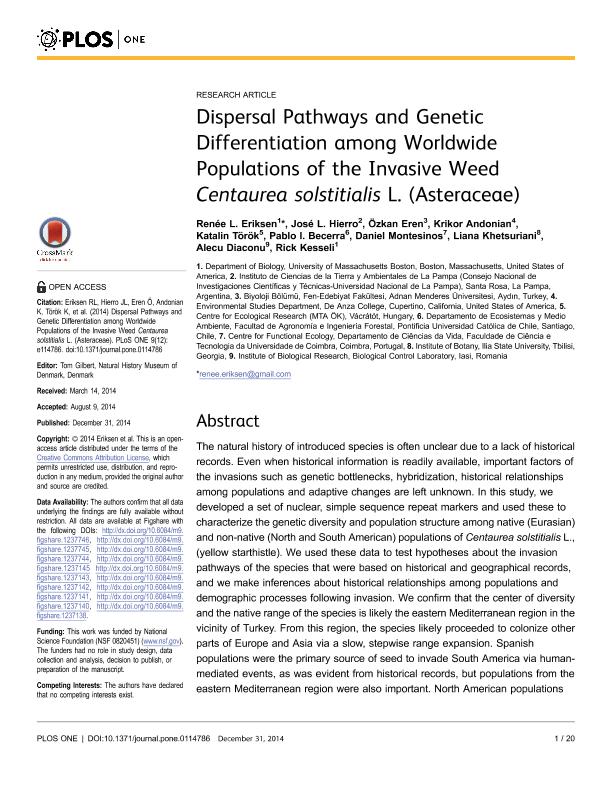Mostrar el registro sencillo del ítem
dc.contributor.author
Eriksen, Reneé
dc.contributor.author
Hierro, Jose Luis

dc.contributor.author
Eren, Ozkan

dc.contributor.author
Andonian, Krikor
dc.contributor.author
Török, Katalin
dc.contributor.author
Becerra, Pablo I.
dc.contributor.author
Montesinos, Daniel
dc.contributor.author
Khetsuriani, Liana
dc.contributor.author
Diaconu, Alecu
dc.contributor.author
Kesseli, Rick
dc.date.available
2017-06-30T20:44:44Z
dc.date.issued
2014-12
dc.identifier.citation
Eriksen, Reneé; Hierro, Jose Luis; Eren, Ozkan; Andonian, Krikor; Török, Katalin; et al.; Dispersal pathways and genetic differentiation among worldwide populations of the invasive Weed Centaurea solstitialis L. (Asteraceae); Public Library of Science; Plos One; 9; 12; 12-2014; 1-20; e114786
dc.identifier.issn
1932-6203
dc.identifier.uri
http://hdl.handle.net/11336/19340
dc.description.abstract
The natural history of introduced species is often unclear due to a lack of historical records. Even when historical information is readily available, important factors of the invasions such as genetic bottlenecks, hybridization, historical relationships among populations and adaptive changes are left unknown. In this study, we developed a set of nuclear, simple sequence repeat markers and used these to characterize the genetic diversity and population structure among native (Eurasian) and non-native (North and South American) populations of Centaurea solstitialis L., yellow starthistle). We used these data to test hypotheses about the invasion pathways of the species that were based on historical and geographical records, and we make inferences about historical relationships among populations and demographic processes following invasion. We confirm that the center of diversity and the native range of the species is likely the eastern Mediterranean region in the vicinity of Turkey. From this region, the species likely proceeded to colonize other parts of Europe and Asia via a slow, stepwise range expansion. Spanish populations were the primary source of seed to invade South America via human mediated events, as was evident from historical records, but populations from the eastern Mediterranean region were also important. North American populations were largely derived from South America, but had secondary contributors. We suggest that the introduction history of non-native populations from disparate parts of the native range have allowed not just one, but multiple opportunities first in South America then again in North America for the creation of novel genotypes via intraspecific hybridization. We propose that multiple intraspecific hybridization events may have created especially potent conditions for the selection of a noxious invader, and may explain differences in genetic patterns among North and South America populations, inferred differences in demographic processes, as well as morphological differences previously reported from common garden experiments.
dc.format
application/pdf
dc.language.iso
eng
dc.publisher
Public Library of Science

dc.rights
info:eu-repo/semantics/openAccess
dc.rights.uri
https://creativecommons.org/licenses/by/2.5/ar/
dc.subject
Dispersal
dc.subject
Founder Effects
dc.subject
Invasions
dc.subject
Natural Selection
dc.subject.classification
Biología

dc.subject.classification
Ciencias Biológicas

dc.subject.classification
CIENCIAS NATURALES Y EXACTAS

dc.title
Dispersal pathways and genetic differentiation among worldwide populations of the invasive Weed Centaurea solstitialis L. (Asteraceae)
dc.type
info:eu-repo/semantics/article
dc.type
info:ar-repo/semantics/artículo
dc.type
info:eu-repo/semantics/publishedVersion
dc.date.updated
2017-06-29T13:57:53Z
dc.journal.volume
9
dc.journal.number
12
dc.journal.pagination
1-20; e114786
dc.journal.pais
Estados Unidos

dc.journal.ciudad
San Francisco
dc.description.fil
Fil: Eriksen, Reneé. University of Massachussets; Estados Unidos
dc.description.fil
Fil: Hierro, Jose Luis. Consejo Nacional de Investigaciones Científicas y Técnicas. Instituto de Ciencias de la Tierra y Ambientales de La Pampa. Universidad Nacional de La Pampa. Facultad de Ciencias Exactas y Naturales. Instituto de Ciencias de la Tierra y Ambientales de La Pampa; Argentina
dc.description.fil
Fil: Eren, Ozkan. Adnan Menderes Üniversitesi; Turquía
dc.description.fil
Fil: Andonian, Krikor. De Anza College; Estados Unidos
dc.description.fil
Fil: Török, Katalin. Centre for Ecological Research; Hungría
dc.description.fil
Fil: Becerra, Pablo I.. Pontificia Universidad Católica de Chile; Chile
dc.description.fil
Fil: Montesinos, Daniel. Universidad de Coimbra; Portugal
dc.description.fil
Fil: Khetsuriani, Liana. Illia State University; Estados Unidos
dc.description.fil
Fil: Diaconu, Alecu. Institute of Biological Research; Rumania
dc.description.fil
Fil: Kesseli, Rick. University of Massachussets; Estados Unidos
dc.journal.title
Plos One

dc.relation.alternativeid
info:eu-repo/semantics/altIdentifier/doi/http://dx.doi.org/10.1371/journal.pone.0114786
dc.relation.alternativeid
info:eu-repo/semantics/altIdentifier/url/http://journals.plos.org/plosone/article?id=10.1371/journal.pone.0114786
Archivos asociados
